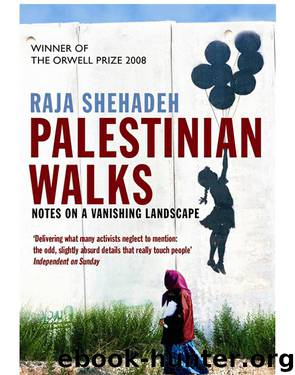Palestinian Walks by Raja Shehadeh

Author:Raja Shehadeh [Shehadeh, Raja]
Language: eng
Format: epub
Publisher: Profile Books
Published: 2009-07-14T04:00:00+00:00
Land acquisition was not the only prerequisite for settlement. Land use planning for their benefit was just as important. Its aim was to designate most empty land for their future use, isolate Palestinian population centres, and fragment their territorial continuity by encircling them with settlements. To achieve this, Regional Plans for the West Bank prepared during the British Mandate were altered and outline plans for most of the Palestinian towns and villages were prepared in great haste in the late eighties. These consisted of plans crudely drawn by felttip markers on photocopies of aerial photographs. Their main purpose was to determine the boundaries within which Palestinian urban development would be confined. Simultaneously outline plans for the Jewish settlements were being prepared with precisely the opposite objective. They reserved the maximum area of land for future development. Under the cloak of law, a highly discriminatory, segregated town-planning reality came into effect. I challenged the legality of these schemes during the last years of the 1980s.
The head of the Planning Council for the West Bank was an Israeli settler who was ideologically dedicated to the settlement project. Even when Palestinians found the financial resources to hire a town planner to prepare proper plans for their village, the Planning Council rejected them and held on to their crude drawings, which confined the village within a border drawn around existing construction. When I asked the head of planning how the village was expected to provide plots for the future expansion of its inhabitants, he would answer with a straight face that they could build up. The image of our beautiful villages in the undulating hills crammed with skyscrapers horrified me.
These developments were forcing me to rethink my strategies. Clearly the legal challenges were ineffective in curbing or even slowing down the extensive Jewish settlements. It was necessary to go beyond the framework of Israeli law and courts. When the Madrid International Peace Conference convened in September 1991 I welcomed the prospect of peaceful negotiations as the only possibility of regaining our usurped land.
But Israel had prepared well for what was coming. They succeeded in confining the scope of the negotiations to 'talks on interim self-government arrangements' for the Palestinians. The settlements, the land designated for them and their administrative and legal links to Israel would be outside the scope of the conference. To enable the Palestinian delegation to argue convincingly the case for the inclusion of these issues was not going to be simple. The head of the Palestinian delegation asked me to help in devising a legal strategy to meet this challenge.
I studied the matter, made my proposals and travelled to Washington, where the negotiations were being held with great expectations. I soon discovered Yasser Arafat, the head of the PLO, instructing the delegation from Tunis, had different concerns. His main aim was to secure recognition for the PLO. Three years later, in the Declaration of Principles, this was achieved at the price of keeping the settlements out of the jurisdiction of the Palestinian Authority.
Download
This site does not store any files on its server. We only index and link to content provided by other sites. Please contact the content providers to delete copyright contents if any and email us, we'll remove relevant links or contents immediately.
How to Read Water: Clues and Patterns from Puddles to the Sea (Natural Navigation) by Tristan Gooley(2849)
Full Circle by Michael Palin(2764)
Into Thin Air by Jon Krakauer(2695)
How to Read Nature by Tristan Gooley(2657)
The Lost Art of Reading Nature's Signs by Tristan Gooley(2281)
In Patagonia by Bruce Chatwin(2262)
Don't Sleep, There Are Snakes by Daniel L. Everett(2212)
City of Djinns: a year in Delhi by William Dalrymple(2130)
L'Appart by David Lebovitz(2113)
The Songlines by Bruce Chatwin(2107)
Venice by Jan Morris(2045)
The Big Twitch by Sean Dooley(2041)
A Thousand Splendid Suns by Khaled Hosseini(1980)
Tokyo Geek's Guide: Manga, Anime, Gaming, Cosplay, Toys, Idols & More - The Ultimate Guide to Japan's Otaku Culture by Simone Gianni(1941)
A TIME OF GIFTS by Patrick Leigh Fermor(1844)
Come, Tell Me How You Live by Mallowan Agatha Christie(1764)
The Queen of Nothing by Holly Black(1748)
INTO THE WILD by Jon Krakauer(1719)
Iranian Rappers And Persian Porn by Maslin Jamie(1706)
